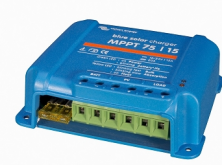In the Victron schematic, I see positive wire connecting LFP battery, starter battery, alternator, inverter.
Negative of LFP battery goes through BMS.
(Some systems might have negative or chassis tied, common, but not this one)
If you connected a DC load directly from LFP to chassis, it would bypass BMS.
Orion is shown as an isolation circuit which instead provides a positive connection that can be controlled, disconnecting load from LFP if necessary.
Note "Other DC Load" with positive and negative connections that you could use without needing Orion. That has negative isolated fro chassis.



